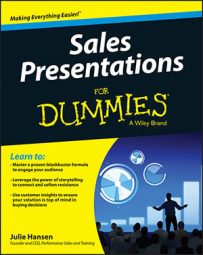Coming up with a theme for your sales presentation is a creative endeavor, and you can approach it in a number of ways. Here are some suggestions to help you find the right theme:
Brainstorm
If you're working as a team, plan a brainstorming session with one rule: There are no bad ideas! If you can't all get together in one place, have everyone list off ten ideas and submit them via email by a certain date. You can then run a poll and pick the top one.
Know your core message
This is the 10,000-foot view of what you're trying to say to your prospect or how you're trying to make her feel. Your presentation itself can be a good source for this core message.
The desired outcome: In discovery you identify what the desired outcome was for your prospect. Can you describe it in a word or two? Is it freedom, innovation, visibility? The first figure below displays an example of using a desired outcome as a theme, in this case momentum.
Background: Prospect is an apartment management company that has recently expanded from 10,000 to 20,000 managed units. The company has also doubled the amount of time it's spending marketing properties, processing applicants, and maximizing occupancy rates, which is keeping the company from achieving its goal of continued growth.
Your value proposition: "Our solution allows you to cut the time spent marketing properties and processing applicants by 75 percent as well as maximize occupancy and rental rates across your portfolio so that you can continue to meet your growth objectives."
Your competitive advantage: If your presentation is focused on "why buy us," you may want to use a competitive advantage (as long as it's important to the prospect) and create a theme around that. A competitive advantage is an area where you outperform your competition. For example, "24/7 access" is a competitive advantage if you offer mobile features and your competitor doesn't, or "Global service" if you're the only vendor to provide full global support. If not, it's just a feature. In the second figure below you can see an example of using a competitive advantage as a theme. Here's how that theme — The Power of Why — was developed:
Background: The prospect is a healthcare provider currently experiencing a rise in call handling times and customer churn although the provider isn't sure why. It's considering replacing the outdated system in its call centers, although it isn't convinced that the impact of additional visibility warrants the investment or that your company is the best choice. Your competitive advantage is your ability to provide key information into why the company is losing customers.
Your value proposition: "We can provide you with visibility into why call handling times are on the rise and customer loyalty is on the decline. The ability to act on this insight will increase agent efficiency and reduce customer churn, which will in turn increase revenue."
Crowdsource it. Crowdsourcing is gathering ideas and opinions from a group of people — typically on the Internet. If you're not sure about what theme to use, you can get input from others by crowdsourcing it in the following ways:
Do a poll or run a contest on Facebook.
Ask current customers what word, phrase, or image comes to mind when describing the results they achieved with your product or service.
Search your prospect's website for core values or causes they support.
Use a thesaurus. After you narrow it down to a few words, check a thesaurus for synonyms or use Synonym Finder to make sure you have the perfect word to convey your theme.
![An example slide of a theme based on achieving a desired outcome. [Credit: Illustration by 24Slides]](https://www.dummies.com/wp-content/uploads/493252.image0.jpg) Credit: Illustration by 24SlidesAn example slide of a theme based on achieving a desired outcome.
Credit: Illustration by 24SlidesAn example slide of a theme based on achieving a desired outcome.![An example slide of a theme based on competitive advantage. [Credit: Illustration by 24Slides]](https://www.dummies.com/wp-content/uploads/493253.image1.jpg) Credit: Illustration by 24SlidesAn example slide of a theme based on competitive advantage.
Credit: Illustration by 24SlidesAn example slide of a theme based on competitive advantage.

